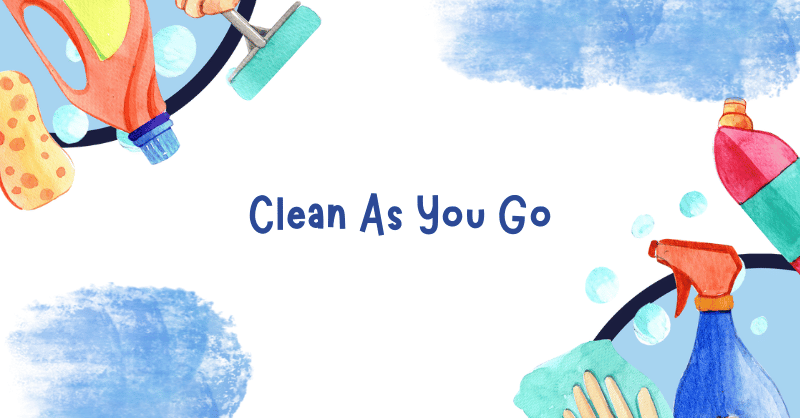Clean As You Go Examples
Here are some examples of ‘clean as you go’ in daily life:
- Take out the trash when it’s full.
- Immediately clean up spills or broken things
- Wipe down the washbasin after brushing your teeth.
- Load dirty dishes in the dishwasher immediately after using them.
- Pick up and put things in their designated place when you see them.
It is applicable in other areas of life too. For instance, mention “clean as you go” to people who’ve worked in the kitchens of Marriott or McDonald’s, and they’ll know what you’re talking about immediately.
Why is it Important to Clean as You Go?
We all know cleanliness is important. But why should we care about ‘clean as you go’? Well, here’s why –
Promote a Healthier, Happier Workplace
Establishing a culture of cleanliness in the workplace is quite challenging. That’s because different people have different habits. But if you are able to establish CLAYGO effectively, you can make people more responsible for their messes.
This is a good alternative to paying the cleaning crew to clean up after people. And with time, cleaning will become a part of the organisation’s culture. The outcome will be a cleaner, healthier workplace where people can thrive with good hygiene and health. And this, in turn, increases employee morale and job satisfaction.
Lower Risk of Accidents and Injuries
A cluttered, unclean workplace can cause plenty of minor accidents and injuries. For instance, it can cause slips, trips, and falls. This can result in bumps, cuts, bruises and, in some cases, broken bones or worse. Luckily, we can prevent many of these accidents by practising the clean as you go method.
Improved Productivity
Employees tend to be more efficient and productive in a safe and clutter-free workplace. Focusing on work is easier when you aren’t concerned about their health and welfare. Also, an employee’s productivity directly correlates with their safety and happiness at work.
Besides, practising ‘clean up as you go’ is actually less time-consuming than leaving the chore for later. And this means employees can allocate more time for more meaningful tasks.
“For every minute spent on organizing, an hour is earned.”
— Benjamin Franklin
Ensure Compliance
The UK has several laws and regulations in place to ensure that every person remains healthy and safe in their workplace. For example, Health and Safety at Work etc Act 1974 covers occupational health and safety in Great Britain. It covers a variety of things, including cleanliness, hygiene and safety programmes.
It’s easier to ensure health and safety for everyone in the workplace with the CLAYGO policy. It positively impacts employee morale and encourages a participative culture while ensuring compliance.
What are the Two Types of Cleaning Categories?
Cleaning categories can be broken down into two types—urgent and non-urgent cleaning.
Urgent Cleaning
Urgent cleaning is needed to prevent an immediate health or safety risk, such as spillage or breakage. For example, suppose you broke a mug in the hallway. If you don’t pick up all the broken pieces instantly and clean them properly, someone might get hurt by them.
Responding immediately to spillages and breakages is crucial for risk management and safety. People might slip and fall, which might lead to breakage, cuts and serious injuries. That’s why you must ensure complete safety at all times. We recommend keeping a safety and cleaning equipment kit for such unfortunate events.


![]() 25 minutes
25 minutes


![]() 25 minutes
25 minutes